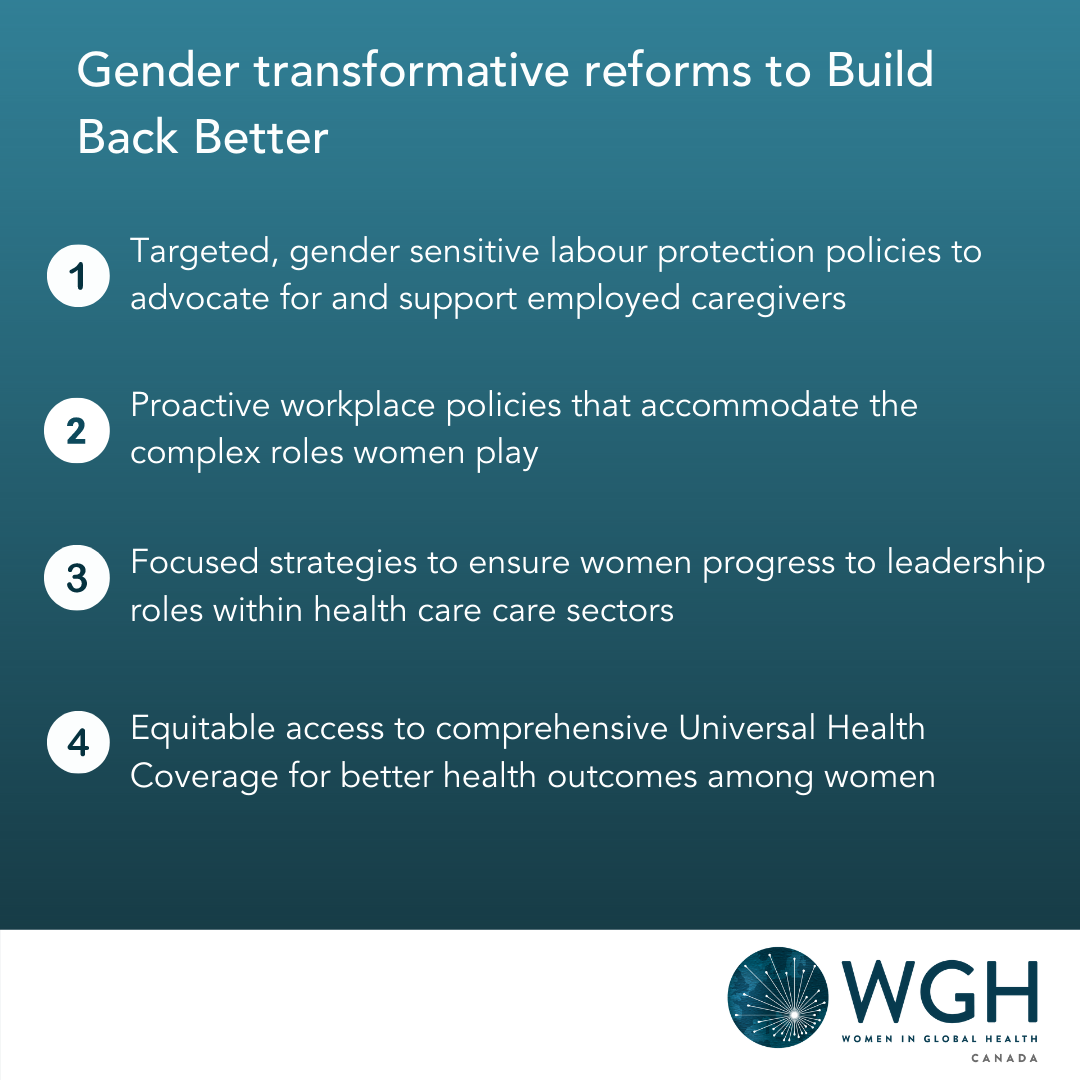By Beverley M. Essue and Felicia Marie Knaul
Abstract
The COVID-19 pandemic has reinforced that women are essential to health and social care globally. In most countries, including Canada, women are shouldering the burden of the pandemic in their work as health and care providers and the impacts of this crisis are magnifying and exposing social inequalities in an unprecedented manner. The United Nations brief on The Impact of COVID-19 on Women reinforces that women are the backbone of the response and calls out the grave threat that the pandemic poses for entrenching pre-existing gender inequalities across societies and nations.
The responses that are rolled out by governments to tackle the economic and social fallout of the COVID-19 pandemic have the potential to lay the groundwork for gender transformative reforms that will better value women in their roles supporting and promoting health. To achieve this, the UN has called for women - their inclusion, representation, rights, social and economic outcomes, equality and protection - to be at the centre of the policy responses. Four recommendations are outlined that would place women at the centre of the response in Canada and collectively, stand to strengthen gender equality and ensure more equitable, fair and sustainable health and care economies as well as a fairer society.
Keywords: COVID-19, Women, caregiving, gender equality
The collateral damage to women from COVID-19 threatens gender equality and could wipe out decades of progress.1,2 In most countries, including Canada, women are shouldering the burden of the crisis in their homes and their work. The United Nations have called out the grave threat that the COVID-19 pandemic poses for entrenching pre-existing gender inequalities, exposing and magnifying existing social inequalities in an unprecedented manner.3 At the same time, the pandemic has provided a much-needed spotlight on the immense social and economic value of work performed by healthcare professionals and paid and unpaid caregivers and reinforced the criticality of women to health and social care.
As the Lancet Commission on Women and Health demonstrated, women are the majority of providers of both paid and unpaid health care globally – conservatively valued at more than 5% of global GDP.4 Women are integral to the COVID-19 response, working on the frontlines as the majority of health care professionals, health facility staff and residential care workers as well behind the closed doors of their homes as essential caregivers.5 The situation in low and middle-income countries will be infinitely worse as lack of hospital beds means that many COVID-19 patients will die at home, largely cared for by women and girls, who will suffer the effects of extended, unprotected exposure to the disease.6
In addition, caregivers of the elderly and frail, and of patients with non-COVID illnesses have been required to take on additional care responsibilities and conduct more complicated procedures at home due to isolation from physicians and usual supportive care teams. Quarantine and physical distancing requirements have required that caregiving be juggled with employment, childcare and children’s education in addition to other household responsibilities.
Women in Canada are heavily involved in the healthcare sector – in 2018, women comprised 82% of all health workers in comparison to just 61% in the total labour force.7 Their involvement in health-related work is vital to safeguarding population health and the viability of the health system. Using methods developed for the Lancet Commission on Women and Health, we estimated women’s contributions to health and the health sector in Canada to be between 6.2% and 7.2% of Gross Domestic Product in 2019. An estimated 35% of the work that Canadian women contribute to support and promote health is unpaid.
COVID-19 presents opportunities to improve gender equality in healthcare and caregiving
Roots of inequality and discrimination based on traditional gender roles create complex realities for women. This invariably impacts how their work is recognized, how they are remunerated in comparison to equally qualified men and whether they can avail opportunities for professional advancement. It behooves us to heed and respond to the UN’s call to ensure that women - their inclusion, representation, rights, social and economic outcomes, equality and protection - are at the centre of COVID-19 policy responses.3
Four recommendations are outlined below that place women at the centre of the response in Canada and collectively, stand to strengthen gender equality and ensure more equitable, fair and sustainable health and care economies as well as a fairer society. The lessons will be transferable to other countries – both of high and of lower-income.

1. Targeted, gender-sensitive labour protection policies to advocate for and support employed caregivers
The pandemic has sparked discussions around the essential nature of eldercare and childcare in Canada and around the world. Being inadequately funded, care facilities are in short supply and unevenly distributed across the country. Pay interruptions and staff layoffs as a result of COVID-19 closures have worsened this reality. In Canada, Quebec has taken proactive measures by announcing that 400 childcare centres will provide care for 60,000 children of health care providers and other essential workers for free.8 Similar commitments across the country would be invaluable for promoting equal participation of women in the health labour force. Coming through this pandemic, childcare and eldercare should be declared as essential services.
2. Proactive workplace policies that accommodate the complex roles women play
The quarantine and physical distancing requirements brought on during the COVID-19 crisis have forced all economies to quickly transition to new ways of working. Where possible, the accommodations that have been made to support employees to work at home should be sustained as a model that is enshrined in workplace policies. Flexible work arrangements are needed to better accommodate the complex roles that employees, especially women, carry out in balancing employment and caregiving responsibilities. Proactive workplace policies can also protect employers against caregiver absenteeism, turnover costs, and promote wellbeing among employees. Providing opportunities for flextime, telecommuting, job sharing, compressed workweeks, personal days off, leave banks and flexible work locations will all serve to close gaps between employee needs and employer expectations.
Companies should reinterpret gender equity policies in the workplace as insufficient leave can lead to poor workplace performance, and difficulty balancing household responsibilities. Employers must develop more flexible workplaces that accommodate caregiving duties and provide better access to paid leave and benefits, including extending leave and benefit entitlements to part-time and low-wage workers, many of whom are women.
3. Accelerate strategies to ensure women progress to leadership roles within health care sectors
Developing and sustaining gender-transformative reforms requires that women are an integral and equal part of all decision-making and leadership structures. Targeted and purposeful strategies are needed to not only attract female talent in the workforce but also create channels and focused succession planning for women to be mentored and trained for leadership roles within organizations, including at the levels of senior management, CEO, and as board members. The advantages of achieving parity in leadership point to greater innovation and overall organizational performance.9-11
Furthermore, analyses of national responses to COVID-19 are pointing to stark differences in leadership styles between nations with female and male heads of state, with the experience from New Zealand under the leadership of Prime Minister Jacinda Ardern standing out as a model for all other nations. The female leadership advantage - a more inclusive, thoughtful and empathetic leadership style - has been purported to be associated with better pandemic outcomes.12
Moreover, consciously shaping hiring and management policies within health and care sectors with inclusion and diversity in mind makes it easier for women to balance professional goals with caregiving. Ultimately, with these intentional work culture changes, employers will see more employees that are productive leading to more productive and healthier societies.
4. Secure and expand universal health coverage for better health outcomes among women
The resources that have been mobilized to confront the COVID-19 crisis have serious implications for future health financing as well as the sustainability of health systems. It will be important to ensure that a gender lens is used to support future planning for health service restoration as well as priority-setting for how to deal with the backlog and waitlists that are accumulating as a result of COVID-related service disruptions. Furthermore, there is a need to ensure an ongoing commitment and investment in women’s health as well as programs and services that support the health of women and girls.
Moreover, fewer women have employer health benefits compared to men. Unemployment and precarious employment situations common among female caregivers worsen this reality. Improving women’s access to necessary health services, particularly for women who are vulnerable due to social disadvantages, is needed to improve health outcomes for women, which will ultimately lead to greater economic participation of women. This is critical in both high-income and low- and middle-income settings.
Conclusion
The decisions made during the COVID-19 response and recovery will be critical in setting a precedent for all future crises of this magnitude and can mark a change for the good in gender equality. The recommendations we put forward identify key opportunities to lay the groundwork for gender transformative reforms to better value and support women, which will in turn support both women and men to achieve their full capabilities and thus enhance their participation in the health workforce and within their homes and communities. These recommendations should be harnessed not only in Canada, but in all countries to better support women and caregiving beyond the COVID-19 crisis.
Acknowledgments
Funding for this research was provided by a research grant from Merck KGaA for a project that measured the economic value of women’s paid and unpaid contributions to the health sector in Chile, Canada and China, as part of a global initiative called Healthy Women, Healthy Economies.
The authors also gratefully acknowledge the generous contributions of the Women in Global Health - Canada team who supported the inclusion and promotion of this paper within the Building Back Better series. The Women in Global Health – Canada team includes: co-ordinators (Dr. Bev Johnson and Eva Slawecki); editors (Barbara Astle and Djenana Jalovcic) and the advocacy manager (Zeba Khan).
About the Authors
Beverley M. Essue, Senior Health Economist, University of Miami; University of Toronto.
Felicia Marie Knaul, Director and Professor, University of Miami.

References
1. Linde A and Laya AG. 2020. What the COVID-19 pandemic tells us about gender equality. The World Economic Forum. May 9th 2020. https://www.weforum.org/covid-action-platform/articles/what-the-covid-19-pandemic-tells-us-about-gender-equality (accessed: 20 May 2020)
2. Wright T. 2020. Broader gender focus needed for COVID-19 response in Canada, advocates say. The Toronto Star. April 10th 2020. https://www.thestar.com/news/canada/2020/04/10/broader-gender-focus-needed-for-covid-19-response-in-canada-advocates-say.html (accessed. 25 May 2020).
3. United Nations. Policy Brief: The Impact of COVID-19 on Women. UN: New York. April 9th 2020. https://www.unwomen.org/-/media/headquarters/attachments/sections/library/publications/2020/policy-brief-the-impact-of-covid-19-on-women-en.pdf?la=en&vs=1406 (accessed: 20 May 2020)
4. Langer A, Meleis A, Knaul FM, et al. Women and Health: the key for sustainable development. Lancet 2015; published online June 5. http://dx.doi. org/10.1016/S0140-6736(15)60497-4.
5. Stall N., Keresteci, M., & Rochon, P. (2020, March 31). Family caregivers will be key during the COVID-19 pandemic. Retrieved from https://www.thestar.com/opinion/contributors/2020/03/31/family-caregiver...
6. Radbrunch L. et al. The key role of palliative care in response to the COVID-19 tsunami of suffering. The Lancet 395(10235): 1467-1469
7. Bourgeault, I. (2018). Women's work across every aspect of healthcare is largely invisible. Retrieved from http://evidencenetwork.ca/womens-work-across-every-aspect-of-healthcare-...
8. Friendly M, and Ballantyne M. 2020. COVID-19 crisis shows us childcare is always an essential service. Policy Options. https://policyoptions.irpp.org/magazines/march-2020/covid-19-crisis-shows-us-childcare-is-always-an-essential-service/ (accessed: 20 May 2020).
9. Kemp L. 2020. Having women in leadership roles is more important than ever, here's why. World Economic Forum. March 3rd 2020. https://www.weforum.org/agenda/2020/03/more-women-in-leadership-shouldnt-matter-but-it-really-does/ (accessed: 20 May 2020).
10. Dezsö, C.L. and Ross, D.G. (2012), Does female representation in top management improve firm performance? A panel data investigation. Strat. Mgmt. J., 33: 1072-1089. doi:10.1002/smj.1955
11. Eagly AH and Carli LL. 2003. The female leadership advantage: An evaluation of the evidence, The Leadership Quarterly. 14(6):807-834
12. Taub A. Why Are Women-Led Nations Doing Better With Covid-19? The New York Times. May 15th 2020. https://www.nytimes.com/2020/05/15/world/coronavirus-women-leaders.html (accessed: 20 May 2020).

